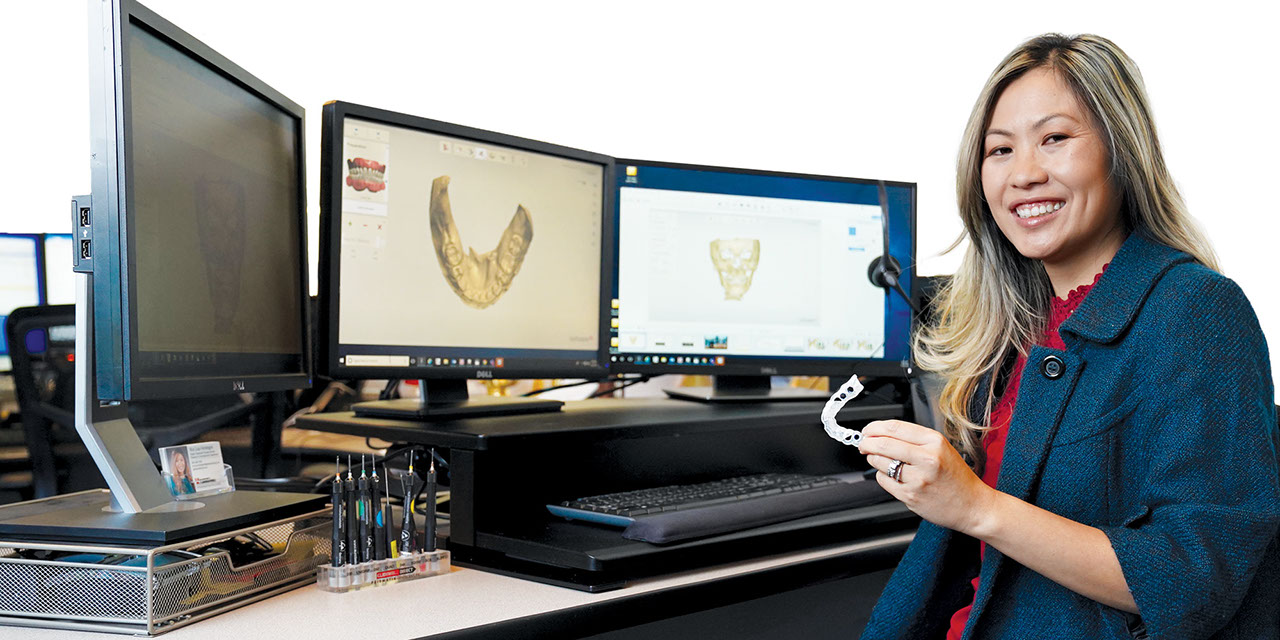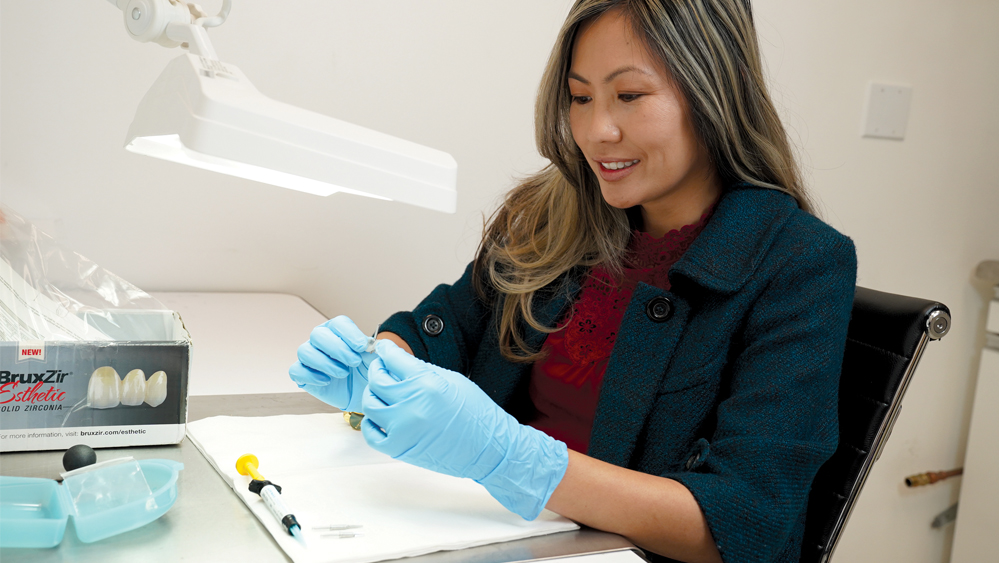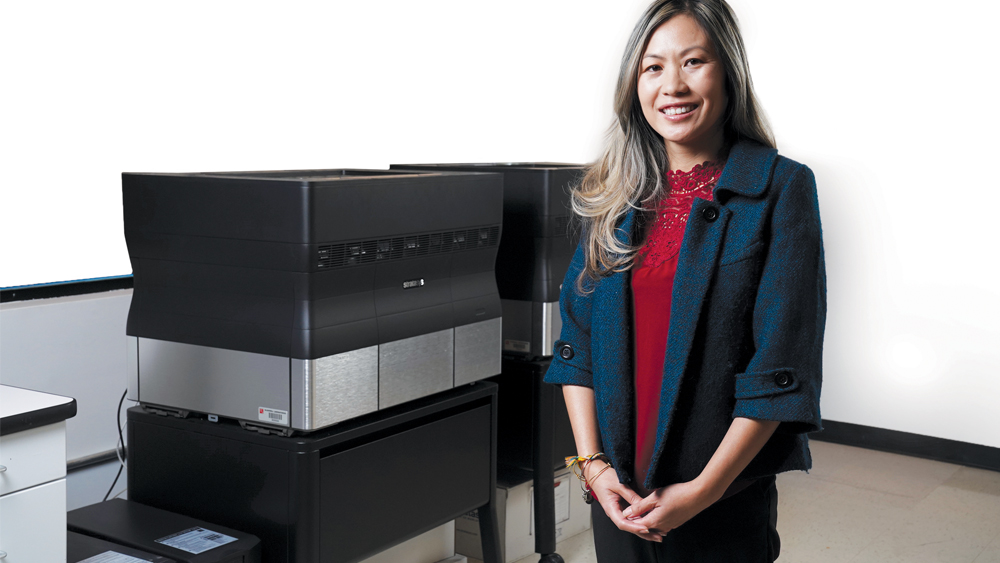Employee Spotlight: Digital Treatment Process Advisor Mui Luu-Verstegen

Mui Luu-Verstegen got her start in dentistry as a sterilization technician more than 20 years ago while still in high school. Her growing enthusiasm for dentistry led her to apply for a technical advisor position at Glidewell. She jumped at the chance to see the dental field from the laboratory side and help doctors get the restoration that their patients needed. Mui is working toward becoming a Certified Dental Technician and, as an advisor in Glidewell’s Digital Treatment Planning department, she also helps doctors plan their implant cases.

Mui Luu-Verstegen inserting a titanium sleeve into a surgical guide produced by the Digital Treatment Planning department. Helping dentists provide a procedure that is both safe and efficient for their patients is one of the aspects Mui enjoys most about her job.
CHAIRSIDE® MAGAZINE: You've been with Glidewell for eight years. How has your experience been moving from a technical advisor to our Digital Treatment Planning department?
MUI LUU-VERSTEGEN: When I first started at Glidewell, my main goal was just to help doctors as much as I could. I wanted every doctor I spoke with to have an amazing experience. As I continued learning about our company, customers and technology, I was blown away by how much opportunity there is here to learn and grow in the dental profession. Digital Treatment Planning is such a special place to work. The surgical guides that we create for dentists help them achieve the exact implant positioning needed for a safe and predictable outcome. So it’s great to be involved in that.
CM: Can you walk us through the process of how a digital treatment planning case gets started?
MLV: The first step is that the doctor would call us to initiate the case. We absolutely need to have the CT scan in order to treatment plan the case. We’ll also want to learn how we’re getting the information about the patient’s oral situation. Is the doctor sending in a full-arch VPS impression or did they use an intraoral scanner? If it’s an intraoral scan, the doctor can just upload the files, along with the CT scan files, to the Digital Treatment Planning portal using the My Account feature on glidewelldental.com. For a physical impression, they’ll just mail it to the Digital Treatment Planning department.
CM: From there, what does the experience look like for the doctor?
MLV: It’s a highly customized and personal experience for the doctor. As their digital treatment process advisor, I work with the doctors at each point in the process from start to finish. If there are any issues after they send in the case, or if they want to change their treatment plan, I will work with them on that and assist them in any way they need.
CM: It sounds like you are intimately involved at every stage of the case.
MLV: Correct. We work very closely with all our doctors, whether they’re placing their first implant or they’ve been placing them for years. Most doctors don’t realize that the Digital Treatment Planning department is sort of like its own little lab. I do everything on their cases. I merge the data from the doctor if they send in a scan, or if it’s a physical impression, then I’ll scan the model and design the case digitally. I treatment plan the case and send the surgical report to the doctor for approval. Once the doctor approves, we generate the digital file used to fabricate the surgical guide.
CM: How does digital treatment planning help the doctor and the patient?
MLV: There are lots of benefits to placing implants through a digitally fabricated surgical guide. It’s more predictable because you can capture and use more anatomical information than you would with a traditional workflow. So the doctor knows ahead of time what’s going to happen. And for the patient, it’s less invasive and so much more efficient.
CM: Could you tell us how digital treatment planning saves the doctor chair time?
MLV: With a digital treatment plan, we eliminate a majority of the questions that the doctor would usually have to work through. We give you the implant length, the drilling sequence and the angulation. The digital treatment plan accounts for the location of all the critical anatomical structures. All of this just speeds up the process and makes it easier on doctors and their patients.
CM: And can your Digital Treatment Planning department offer this for any implant system?
MLV: We support virtually all major implant systems on the market. But if doctors use the Hahn™ Tapered Implant System, they’ll get a 20% discount off their final restoration. Not only is Hahn a great system, but they’ll also have the opportunity to get the Hahn Bundle — which includes the surgical guide, implant, healing abutment, and either the impression coping or scan body —for a price that significantly reduces the cost of this type of treatment.
CM: What turnaround time can doctors expect with the digital treatment planning workflow?
MLV: Usually, we can do the treatment plan and print the surgical guide in three to five days. If the production floor is particularly busy, it can take up to eight days to treatment plan and then five days to print the surgical guide. But we’ll always let the doctor know that ahead of time.
CM: How have doctors responded to the experience they get with digital treatment planning?
MLV: The doctors love the personal and hands-on treatment they get from their digital treatment process advisors. We offer them a step-by-step process for placing their implants successfully, with access to all of the amazing technology that Glidewell has invested in and developed.
CM: When you’re not helping doctors, what do you enjoy doing in your free time?
MLV: I love spending time with my two daughters. We love baking together and making goodies like brownies, cupcakes or cookies. But my specialty is my banana pudding. Sometimes I’ll make some and bring it in for my team members, which they love.
CM: Thank you for your time, Mui. We loved hearing about your passion for our doctors and their patients.
MLV: My pleasure.

Mui works with dentists to create digital treatment plans and design surgical guides that help position the implant in the precise location needed for a predictable and esthetic outcome. The Digital Treatment Planning department uses advanced 3D software to digitally determine the optimal implant position for guided surgery cases. Here, Mui is standing in front of the 3D printers used to fabricate surgical guides based on digital treatment plans she develops in collaboration with dentists.

Mui with her husband and two daughters, with whom she shares a passion for baking.


